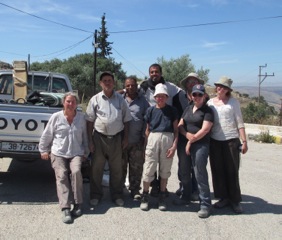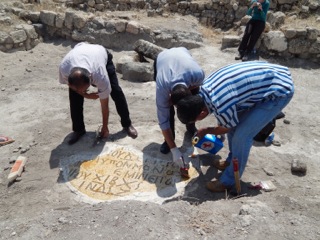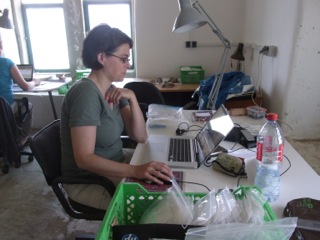Processing campaign in May 2014
The campaign 2014, which took place in Umm Qais from 29 April to 29 May, focused on very different tasks. As usual, the campaign was chaired by Prof. Dieter Vieweger and Dr. Jutta Häser.
At the beginning of the campaign, Dr. Knut Rassmann and Dr. Samantha Reiter conducted a three-day geomagnetic survey on Tall Zirā'a. It should mainly provide information about the upper layers between areas I and II as well as the area around the artesian well.The evaluation of the measurements has not yet been completed.
Excavation in the Area III
A test section under the direction of Dr. Ursula Rothe and Dr. Frauke Kenkel was installed north of Area III.They were supported by Richard Hunsdörfer and Astrid Bongartz.

Ecavation team of Area III
The aim of the excavation was to determine the extent of the large building that was excavated in 2008 in the direction of the well, and to examine whether the Byzantine building is likely to have older layers.
In the 14-day excavation the continuation of the Mameluck/Abbasside, the Umayyade and Byzantine buildings could be recorded. The extent of the Byzantine building, however, remains unclear. The presence of older layers is due to Roman ceramics, but these have not been achieved so far.
During the campaign, a mosaic was uncovered, which had already been discovered in 2008, but could not be investigated at that time. It has a Greek inscription, which provides statements on the dating and the creation. The evaluation has not yet been completed.
The findings of this test excavation were treated by Dr. Jutta Häser, Dr. Stefanie Hoss and Dr. Frauke Kenkel.

Salvage of the mosaic in Area III
Publication preparation
Dieter Vieweger was mainly concerned with the ceramics of the Bronze Age and Iron Age strata 16 to 11 from Tall Zirā'a in preparation for their publication.
Dr. Jutta Häser completed the investigations on Stratigraphy in Areal II and correlated these, in collaboration with Susan Schütz, with Strata 1 to 10 in Area I.
Furthermore, the studies on the objects for textile production such as weaving weights, spindle whorls and weaving spatulas were continued.
Katja Soennecken worked on the Bronze Age and Iron Age findings in Areal I, which form the basis of her dissertation on the settlement development in the southern Levant.
Patrick Leiverkus and Katja Soennecken continued their work on the findings of the Wadi al-'Arab-Surveys, which they carried out in 2009 and 2011.
Susan Schütz was involved in her dissertation on "Living in the Chora: A phenomenon of Roman culture using the example of the Tall Zirā'a in the Dekapolis (working title)" with the Late Hellenistic and Roman findings and finds of Strata 9 to 7 of Tall Zirā'a.
Dr. Stefanie Hoss worked on the ancient glass and metal finds of the Tall Zirā'a from the areas I to III and prepared the catalog for the publication .

Stefanie Hoss processing glas finds
Marie Schulze and Dr. Robert Lehmann carried out XRF measurements on glass and metal samples of different times from Tall Zirā'a to investigate their composition and possibly to determine the origin of the raw material by comparing them with other finds.The investigations are part of the master thesis of Marie Schulze.
Linda Whittacker dealt with the soil samples from various excavations on the Tall Zirā'a to possibly make statements about paleobotany.
Once again, Anke Laderick and Antje Cassel helped us as volunteers in our work - without them such a smooth process could not have been possible!
Guests
During the campaign, many guests were welcomed at Tall Zirā'a and at the Umm Qais excavation house. Particularly noteworthy are the delegation of the German research community, representatives of the German Embassy and the German-speaking communities in Jerusalem and Amman.
Acknowledgment
We thank the following institutions for the financial support of this campaign:
Protestant Church in Germany, Biblical Archaeological Institute Wuppertal, German Research Foundation, German Academic Exchange Service, German Archaeological Institute, University of Hannover, Open University of Manchester, Center of British Research in the Levant.
We would like to thank the Department of Antiquities of Jordan and especially its representative, Ibrahim Rusan.
Status of information: 2014
|
CURRENT NOTE (2017) The results of the all campaigns from 2001 to 2011 are represented in detail in the final publication. |
|
Project Partners |
|
Biblical Archaeological Institute Wuppertal (BAI) |
|
Patronage |
|
His Royal Highness Prince El Hassan bin Talal took up the patronage of this project as a representative of the royal house. |
Friends and Donors |
|
Cooperations |
|
We cooperate closely with many universities, institutes and companies.  |

 print version
print version
